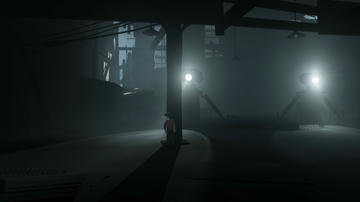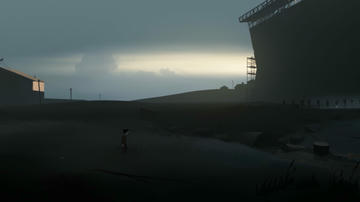Inside
Playdead, 2016

Limbo was an extraordinary hit back in 2010 for the Danish game developer Playdead. It redefined side-scrolling adventures, by eschewing the day-glow chaos of typical platformers, and instead delivering a nightmarish world of monotone terror and despair. I played it and loved it: the character animation, subdued palette, haunting atmosphere and balanced puzzles made for a memorable game that’s stayed with me.
Inside treads a similar path: the game is a moody and mysterious side-scroller, with a dark palette and brooding atmosphere. Like Limbo, the main character of Inside is an unnamed boy, travelling across a dystopian landscape for reasons unknown. At first glance it seems there’s little difference between the two games, but after just a few minutes of playing, it’s clear that Inside is much more than just Limbo 2.0.
Setting
The world of Inside is bleak and mysterious. There’s no backstory, no dialogue, no speech or text of any kind. It’s up to the player to infer a story, and it’s the uncertainty about what’s going on that makes this game so interesting.
The player character enters the world stage left, sliding down a bank into a dark forest. The first problem seems to be to avoid dark shadowy figures who are looking for us. Dogs are set on us and cars chase us. Yet despite these threats, the forest itself seems the most dangerous of foes. The brooding aesthetic makes those dark trees seem rather menacing. I feel oppressed as I control the boy in the red top: the world itself is against me. I’m compelled by an instinct of flight to guide him to safety.

The 3D world (played in side-scrolling two dimensions) is itself the storyteller. I’m guided through scene after scene of the curious and bizarre, the bleak and the wondrous, and later the downright weird. The story plays out as I progress, sometimes dictated by my actions, other times through background details, or incidental action that I have no control over. It’s a world of cause and effect, although neither my cause nor my effect were ever completely clear, even after the game was over.
It’s hard to say whether this is good narrative design: I loved the approach, but I can see how others might find it much too ambiguous. It’s rare that a game gives us room to infer our own story, and it’s the aspect of Inside that I most enjoyed.
I engaged with redtop as he ran, jumped and mind controlled his way through this strange dark world. From the rain sodden forest, to a waterlogged pig farm; from the deserted country side to a dystopian city, and on through stranger and more confusing spaces: under the sea, inside a sunken ship, an abandoned mine, bleak industrial warehouses, flooded office blocks, a strange laboratory. Despite the monochrome aesthetic, every area bears its own identity and its own set of self contained puzzles. And that’s the real heart of the game: the puzzles.
Mechanics
Inside is a puzzle game. To progress, we must guide redtop through bizarre, if simple puzzles. Puzzles range from ‘push-the-box’ affairs to full on mind-control of faceless humans. Each puzzle is short yet memorable, and each puzzle advances our understanding of the world we’re in and the rules that govern it.
What’s interesting about the puzzles, is their purpose in telling the story. Many puzzle games have illogical puzzles with arbitrary solutions. These often don’t make any sense in the context of the game’s world. Inside rarely falls into that trap. Sure, some of the puzzles are downright weird, but in solving them, a little snippet of story becomes clearer.

One example early on sees redtop passing through a dreary, abandoned farm. Dead and dying pigs litter the ground, and one seems to be still alive, its tail flicking from side to side. But it’s not a tail at all: it’s a parasite and it seems to have control of our porcine friend. Ignoring the pig, I continue through the farm and find an impassable puzzle: a strange device is hanging from the barn roof, but I can’t reach it. In the background I can see two faceless people, one hunched on the floor, one in a cage. Redtop needs to be taller… if I could stand on a pig, maybe I can reach the peculiar device? I return to the pig with the parasite up its bum and pull hard. Out comes the disgusting worm, and the pig revives. I can now use the pig to reach my goal.
This sounds quite bizarre, but it’s a tiny step on the scale of weird that’s the story of Inside. It’s a perfect example of the drip-feed reveal of the disturbing narrative. This scene is very short, yet it conjures so many questions about this grey world and our purpose in it. What are those parasites? Where did they come from? Why are they inside those pigs? What is the device hanging from the barn roof? Who are those faceless people? Why are they not moving? If you pay attention, you can start to answer those questions for yourself.
Sound and visuals
Inside is a stunning looking game. At first glance, I could understand some people dismissing it as dreary. But this dark style is perfect, and shows that the developers knew exactly what they wanted to achieve.
The limited palette gave Playdead great constrains in their art direction. Any creative person knows that constraints can create some of the most interesting work. The designers have used those constraints to their greatest advantage. The world is in 3D, but we only see it side on, and this gives each scene great depth. The style is simplistic: there are no photo-realistic textures or excessive detail. The world renders in blocks of of flat colour, and the style reminded me of Another World, the classic Amiga game. The clever use of limited lighting is also very well done. Subtle lights direct the player to their next goal, or highlight something to investigate.

Some scenes show small shadowy details in the distance, and I struggled to work out what was going on. But as I moved on, the background became closer and those details revealed. Playing with lighting and depth allows the designers to sow seeds of the story and reveal their answers much later. It’s a very powerful technique.
I should also mention the animation. The characters move with the sort of grace and fluidity rarely seen in a side-scrolling adventure. I recalled the style of the original Prince of Persia. Playdead spent a good 3-4 years working on this game. It’s clear that they spent a huge amount of that time perfecting the art and animation. It’s superb.
Like Limbo, a large part of the Inside experience is the sound design. Every small detail is perfectly crafted. Whether it’s the spot sound effects of redtop as he moves around, or the haunting ambient soundscapes, nothing is overdone or superfluous. Once again I was captivated by this bleak world, drawn into its story through the music of its mystery.
Halfway through the game there’s a sequence underwater, in which the player controls redtop in a small spherical submarine. Eventually we come across a strange creature that does not have our best interests at heart… and the sound that underlies this sequence really put me on edge. It’s a creepy part of the game and it’s perfect.
Once again Playdead have surpassed themselves in complementing their dark aesthetic with a spot-on soundtrack.
Summary
I absolutely loved this game. It’s a clever and dark puzzler with an interesting story. It questions the notion of what games are. The bonkers ending is hilarious and disturbing and raises far more questions than it answers. There’s a second ending too which goes even further in making a point about the notion of control in games.
I’d have no reservations in recommending this game. It’s inexpensive and quick to play and is well worth six hours of your time. A modern classic.